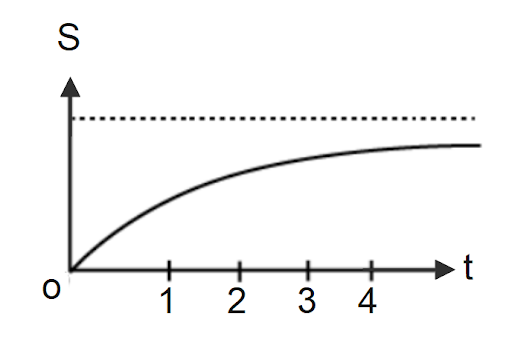
The displacement of a particle as a function of time as shown in the figure. It indicates

A. the particle starts with a certain velocity, but the motion is retarded and finally the particle stops.
B. the velocity of the particle decreases.
C. the acceleration of the particle is in the opposite direction to the velocity.
D. the particle starts with a constant velocity, the motion is accelerated and finally the particle moves with another constant velocity.
Answer
147.9k+ views
Hint: In this question, we are given a figure in which displacement of a particle is shown. We have to choose the option which our figure satisfies. We see that at origin slope is not zero and with the increase in time slope is decreasing. Then we choose the option which our figure satisfies.
Complete step by step solution:
We are given a figure in which the displacement of a particle as a function of time. We know that the slope of the s-t graph represents velocity. Initially at the origin, slope is not zero, so the particle has some initial velocity. With the increasing time we see that the slope is decreasing and finally the slope becomes zero, so the particle stops finally. As the magnitude of the velocity is decreasing, so the velocity and the acceleration will be in opposite directions.
Hence, options A,B and C are correct.
Note: We say that the displacement varies with time or is a function of time t.
We know the equation
This clearly shows that the displacement depends upon time.
Complete step by step solution:
We are given a figure in which the displacement of a particle as a function of time. We know that the slope of the s-t graph represents velocity. Initially at the origin, slope is not zero, so the particle has some initial velocity. With the increasing time we see that the slope is decreasing and finally the slope becomes zero, so the particle stops finally. As the magnitude of the velocity is decreasing, so the velocity and the acceleration will be in opposite directions.
Hence, options A,B and C are correct.
Note: We say that the displacement varies with time or is a function of time t.
We know the equation
This clearly shows that the displacement depends upon time.
Recently Updated Pages
JEE Main 2023 (January 29th Shift 1) Physics Question Paper with Answer Key

JEE Main 2021 July 20 Shift 2 Question Paper with Answer Key

JEE Main 2023 January 30 Shift 2 Question Paper with Answer Key

JEE Main 2022 (June 24th Shift 1) Physics Question Paper with Answer Key

Equivalent Capacitance - Important Concepts and Tips for JEE

JEE Main 2023 (April 6th Shift 1) Physics Question Paper with Answer Key

Trending doubts
JEE Main 2025 Session 2: Application Form (Out), Exam Dates (Released), Eligibility, & More

JEE Main Exam Marking Scheme: Detailed Breakdown of Marks and Negative Marking

JEE Main 2025: Derivation of Equation of Trajectory in Physics

Electric Field Due to Uniformly Charged Ring for JEE Main 2025 - Formula and Derivation

JEE Main Participating Colleges 2024 - A Complete List of Top Colleges

Degree of Dissociation and Its Formula With Solved Example for JEE

Other Pages
JEE Advanced Marks vs Ranks 2025: Understanding Category-wise Qualifying Marks and Previous Year Cut-offs

JEE Advanced 2025: Dates, Registration, Syllabus, Eligibility Criteria and More

Units and Measurements Class 11 Notes: CBSE Physics Chapter 1

NCERT Solutions for Class 11 Physics Chapter 1 Units and Measurements

Motion in a Straight Line Class 11 Notes: CBSE Physics Chapter 2

JEE Advanced Weightage 2025 Chapter-Wise for Physics, Maths and Chemistry




